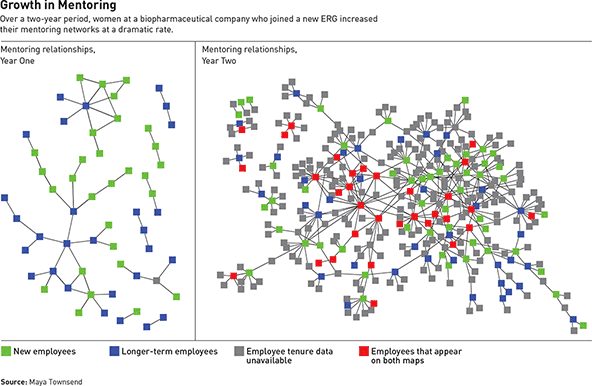What you can learn from your employee networks
Many companies support resource groups that bring people together, but stop short of assessing their value.
At many large organizations, employees have the opportunity to participate in groups that bring together coworkers with various commonalities. According to estimates (pdf) from the Employer Assistance and Resource Network on Disability Inclusion (EARN), more than 90 percent of Fortune 500 companies have such networks. Often referred to as employee resource groups (ERGs), these networks provide a place for women, veterans, LGBT employees, people of color, people with disabilities, working parents, and others to connect with one another and help ensure that the workplace welcomes and supports their productivity.
From the first U.S. ERG — formed by African-American employees at Xerox in 1964 to address issues of discrimination — through today, these groups have helped their members build internal networks, access mentors, and gain knowledge. Yet even though the number of ERGs has taken off, companies seldom assess these groups’ success. It’s rare for a popular corporate mainstay to go unmeasured, but the value of ERGs is notoriously difficult to quantify. And without data, leaders may question whether it makes sense to actively support the ERGs in their organization.
We know that the activities associated with ERGs have general value. Networking, for example, is linked (pdf) to an increase in promotions and in compensation, to greater career satisfaction, and to salary growth. Mentoring also yields demonstrated benefits: People with mentors are more likely to receive promotions and salary increases (pdf). The question is whether a given organization’s specific ERGs are succeeding. One biopharmaceutical company, which I’ll refer to here as the Alpha Corporation, sought to go beyond anecdotal evidence to assess the successes — or failures — of its Women’s Success Network (WSN). This study reveals how companies can review their ERGs to ensure that they are achieving their goals and reaching their target employees. The results can either justify continued investment or be used to address shortfalls in the ERG’s progress.
Early Enthusiasm
When I arrived at Alpha to help assess its WSN, the group had been in existence for 18 months. It was formed by employees at various levels in the corporate hierarchy who wondered why there were so few women at the senior director level and above, even though roughly half of the company’s employees were women. The WSN’s first year and a half had seen a flurry of activity: “lunch and learn” sessions, leadership team formation and goal setting, and fundraising. An early accomplishment was a large “path to success” event that featured keynotes from company executives, breakout sessions, and frank conversations about how to help women thrive at Alpha.
Employee response had been enthusiastic. Women showed up in droves for events, at which there was a palpable energy in the room, and company leaders willingly gave their time to the new group. The WSN’s email list grew rapidly. But Alpha was used to empirical evidence; it wanted proof that the WSN was accomplishing its goals.
The measurement approach we used was based on organization network analysis (ONA), a method that examines transactions among people. Networks exist in every company. They are made up of the hidden webs of relationships that people use to get their work done. Network quality, diversity, and strength affect how well organizations share knowledge, collaborate, learn, improve, and execute their strategies.
Network quality, diversity, and strength affect how well organizations share knowledge, collaborate, learn, improve, and execute their strategies.
ONA reveals how these hidden networks operate. The methodology was developed by academics and researchers after years of study in biology, mathematics, physics, and anthropology, as well as work with businesses around the world. The analysis is usually conducted electronically. Participants receive a link via email to a Web-based assessment that takes about 15 minutes to complete. The assessment asks each respondent to identify who they know within the group of survey participants and how they work with each person identified. Depending on the specific goals of the ONA, they may be asked who they go to for expertise, outside-the-box conversations, mentoring, or ad hoc decisions.
When all participants have completed the assessment, the data is run through algorithms that analyze relationships, find critical connectors, and gauge the overall health of the system. The data is transformed into network maps that visually show the connections among people.
Tracing Complex Networks
By comparing interaction frequencies and functions, such as sharing expertise, socializing, and problem solving, Alpha was able to assess how the WSN had grown and how it enabled its members to connect productively. Alpha’s WSN chapter engaged in two nearly identical assessments over two years. During the time between the assessments, the chapter grew. In the first year, 343 people were on the mailing list; by the second year, the number had grown to 634. This increase in numbers was a positive sign. But were people engaging? Or simply receiving emails?
To assess degree of engagement, we examined the maps. The Year One and Year Two network maps looked very different. The Year One map was sparser and included “isolates,” people who weren’t attached to anyone else in the network. The Year Two map was dense and included many fewer isolates. In other words, new WSN members weren’t just receiving emails. They were engaging with other network members and with people they wouldn’t normally interact with on the job.
Such cross-functional connections were important for Alpha. The organization tended toward silos, yet the nature of the work required collaboration across department lines. Before the WSN, employees’ ability to collaborate was often dependent on who they worked for. One associate director observed, “I’ve talked with people who assumed that their manager wouldn’t be open [to cross-functional interaction] or who have known for sure that their manager hasn’t been open to it.” As a result, many women felt locked within their departments. The network gave them the venue and opportunity to create relationships outside their areas.
These relationships, which tended to be social at first, were an important initial goal for the network. Many employees were scientists and prone to favor hard work over relationship building. Said one employee: “I’m an introvert. I don’t know what to do. I don’t know who to reach out to.” Indeed, the primary reason people said they wanted to connect with other WSN members during Year One was socializing.
Once the network formed, however, Alpha’s leaders wanted the group to go beyond socializing to help women address work-related issues. Interestingly, the Year Two maps showed an important shift: Socializing became the least frequent use of the network. The majority of activity focused on knowledge sharing and conversations about how to improve work — just the sorts of things the WSN wished to encourage.
Another important reason for the WSN’s formation was to encourage mentoring among women. The founders knew that Alpha was difficult to navigate and much depended on relationships. It was important to know the right people, but women often struggled to find those people. Mentors provided women valuable advice and support in navigating the complex organization structure.
When we looked at the mentoring map (see “Growth in Mentoring”), we saw something interesting and promising: Newcomers to the organization were more likely to seek mentoring relationships in Year Two (image at right) than Year One (image at left). The increase in mentoring among new members signaled that the WSN was reaching out and engaging newcomers effectively. In addition, more mentoring activities were occurring in Year Two than in Year One — more than could be attributed to simple network growth.
Alpha also hoped that the WSN would accelerate and simplify the process of finding expertise within the company’s large, sometimes confusing organization structure. The results showed that the number of people offering expertise within the network more than doubled in Year Two. The number of expert connections per person also increased. In Year One, people had an average of 2.7 connections related to expertise. In the following year, that number jumped to 4.2.
In other words, new members weren’t responsible for the increase in expertise-sharing activities. Individuals overall were more active in sharing their expertise. This confirmed that the WSN was helping women improve their access to information. Indeed, more than 60 percent of survey respondents cited access to expertise as an important benefit gained from participation.
A final question raised by the company related to sustainability. Was the ERG dependent on a few activists without whom the network would collapse? When the network began, a core group of passionate people did indeed provide the drive and focus. By Year Two, however, the map showed that the network had shed its dependence on its founders. There was less reliance on hubs, that is, the people who had more connections than others and did more to engage with the group. Furthermore, only three of the 11 hubs in the Year Two network were members of the WSN leadership team. This showed that the network was effectively extending beyond its core group and building the kind of resilience it would need to flourish even if the founders withdrew or moved on.
A Model for Measurement
Overall, the results of the network analysis showed that the Women’s Success Network was meeting its goal. When the group was formed, 30 percent of employees at the director level and above were women. Today, 43 percent of directors and above are women. Although Alpha can’t draw a specific connection between the WSN and this shift, the anecdotal evidence suggests that the group’s progress has helped set more women on a path toward advancement within the company.
To measure the effectiveness of your company’s ERG, learn from Alpha’s experience and consider the following actions:
• Know what you want to know. A survey can measure anything, or nothing. Taking the time to clarify what data is most critical will ensure that the survey tool you develop produces the information you need. Too many surveys are hastily constructed and generate results that don’t answer critical questions.
• Connect the dots. It is hard to draw direct lines between ERG activities and performance. But it can be done. ONA, paired with a quantitative survey, generates images and concrete data that show how ERGs grow over time, increase activity in targeted endeavors, and help members achieve their goals.
• Use maps to paint compelling pictures. The visual maps generated by network analysis provide dramatic pictures showing how networks change over time and how they increase or discourage targeted behaviors. Many leaders respond well to these images and appreciate the visual evidence of progress (or lack thereof).
• Measure growth over time. The real value of measurement is assessing year-over-year network progress and value. Organizations that commit to multiple annual surveys gain deeper insight into how networks grow and contribute to member leadership and productivity within the organization.
By committing to recurring network studies, Alpha achieved what most organizations fail to produce: concrete evidence that its Women’s Success Network was generating positive results, enabling women to empower themselves and one another.
Author profile:
- Maya Townsend is founder of Partnering Resources, a consulting firm that specializes in strategy within complex ecosystems and human network development. She is coeditor of the Handbook for Strategic HR and author of numerous articles.






